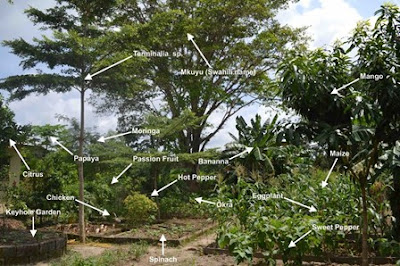PDC LESSON 1.4 PRINCIPLES OF STABILITY
PERMACULTURE COURSE AGRO-ECONOMY
PDC LESSON 1.4 PRINCIPLES OF STABILITY
It is not the number of diverse things in a design that leads to stability; it is the number of beneficial connections between those components.
COMPANION PLANTING:
Is the siting of plants in such a
way as to benefit either one or both species? Plants to attract predator insects may
be planted within or bordering a main crop. Scientific studies have been mixed,
with some studies showing no effect or even a decline in yield. One productive
intercrop is corn with beans and cucurbits. The best advice is to investigate
then experiment in your own garden.
GUILDS:
A guild is an
important term used in permaculture that expands on the concept of companion
planting. It is used to decide a harmonious assembly of species clustered
around a central element (plant or animal). For example, a guild may consist of
a fruit tree, a legume to provide fertilizer and shade, ground crops to stop
weed invasion, mulch plants such as comfrey and lemon grass, a climbing food
plant such as beans or cucurbits climbing up the fruit tree, and plants
and herbs to assist pest control.
APPLY
SELF-REGULATION AND ACCEPT FEEDBACK
We need to discourage inappropriate activity to ensure
that systems continue to function well.
It is the number
of neural connections not the number of brain cells that leads to intelligence.
Text from the roots, Mollison, Holmgren, (Aus.) also Bratt Pritchard.



Comments
Post a Comment